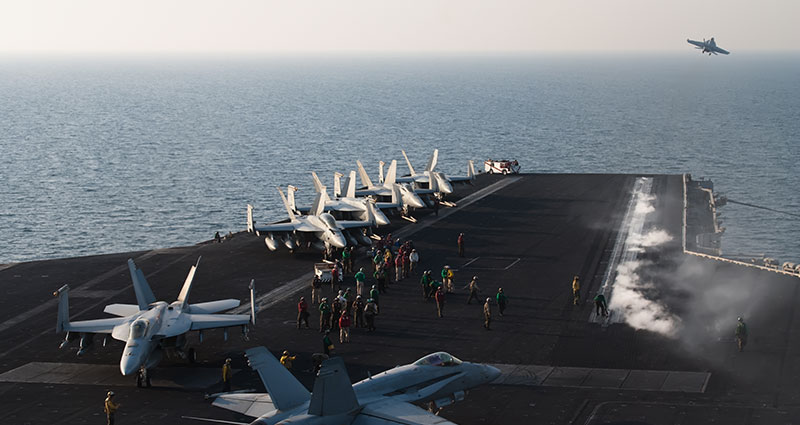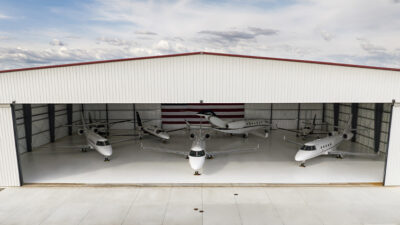Strong Up the Middle

A few months ago, I was given a once-in-a-lifetime opportunity to spend two days on board a United States aircraft carrier—the USS Abraham Lincoln—while she was at sea conducting flight operations. It was an immersion experience that will forever change the way I look at work and life. No kidding.
Life in a “Floating City”
Some may have heard large Navy ships described as “floating cities,” a metaphor that doesn’t quite go far enough to describe what I was privileged enough to witness. Yes, the basics of scale seem to fit. The Lincoln is 4½ acres of sovereign U.S. territory, has 5,000 residents, a water processing plant that purifies 400,000 gallons per day, “restaurants” that are open 24/7 and serve 18,000 meals a day, a small hospital and dental clinic, and even a chapel.
The difference between your typical-small-town metaphor and the real world of carrier operations is that this city moves and has a lot of things moving around it—very loud, very fast and very dangerous things. One more thing: There is zero unemployment in this city and everyone works 12-hour shifts, every single day, for months at a time doing incredibly dangerous things.
And therein lies the real magic. American sailors, who average 21 years of age—with many younger than that—all combine to do complex operations that to the outside world or untrained eye might be considered damn near miraculous. But it’s not—its routine.
Carrier Ops and Commercial Aviation Compared
I want to step back from this scenario for a minute to compare this to what I see far too often in the world of general, business and even commercial aviation—industries that would initially seem to have incredible advantages with regards to safety and operational efficiency.
First, the workers are paid much better, get to go home and rest most nights and have far greater experience. Nearly all are licensed and certified by some federal regulator and are well-resourced. Yet we continue to see incidents and accidents that result from multiple causes, the most common being “failing to follow standard operating procedures or technical guidance.”
Now back to the Abe Lincoln. Others have already described what these men and women do as “high-reliability operations” but that management speak does not begin to describe what I witnessed. It’s been a few days since I returned from the catapult shot off the bow (think of the craziest roller coaster you have ever been on and quadruple it) but here are a few things that are beginning to emerge in my head.
Middle management is the key. The chiefs are highly experienced, no-nonsense leaders in the truest sense of the word. They know their sailors, even with a 35% plus turnover rate every year. They also know the standards and ensure they are being met. I witnessed more than a few “corrective sessions” taking place in various functional areas. All done with respect, but also with a firmness that left little doubt about the expectations.
Addressing the “Messy Middle”
When I contrast this with what I see all too frequently in the civilian world of aviation—first line supervisors who are struggling to lead—it is easy to see where the biggest opportunity for improvement lies. Put simply, if we fail to train, mentor and appreciate the vital role of the “messy middle,” we sacrifice the most critical link in the safety and performance chain: the ability to grow our line workers and hold them accountable for their work. We need to become stronger up the middle.
There is nothing “messy” about the middle ranks on an aircraft carrier. The chief’s mess is, quite literally, hallowed ground. It is respected by everyone aboard—even the commanding officer, who tradition demands must ask permission or must be invited into this area. This might seem silly to outsiders but is indicative of the respect provided to this elite group of leaders and mentors. It is here where the strategy and direction from senior leaders is ground down into repeatable execution.
Senior leaders fully understand this performance dynamic. Without strong middle management—better said middle leadership—it doesn’t work. If we really want to improve safety, operational effectiveness and efficiency, perhaps it’s time to focus a lot more on our core strengths: first line supervisors and other middle managers across all of our functional areas who have been too long overlooked and underappreciated.

Convergent Performance is uniquely dedicated to reducing human error in high risk environments.
http://www.convergentperformance.com/
© 2025 Convergent Performance. All Rights Reserved.
Next ArticleRelated Posts

Part 108: The Next Step in BVLOS Integration and Drone Innovation
As the drone industry awaits the Federal Aviation Administration’s (FAA) forthcoming Part 108 regulations, the landscape of Beyond Visual Line of Sight (BVLOS) operations stands on the brink of transformation. These anticipated rules aim to standardize BVLOS flights, enabling more complex and expansive drone missions across various sectors.

Navigating Geopolitical Uncertainty Using Business Aviation
Bigger business jets mean bigger fuel tanks, longer trips, more border crossings, and bigger wallets! With an equipment upgrade also comes the requirement for a knowledge upgrade.

